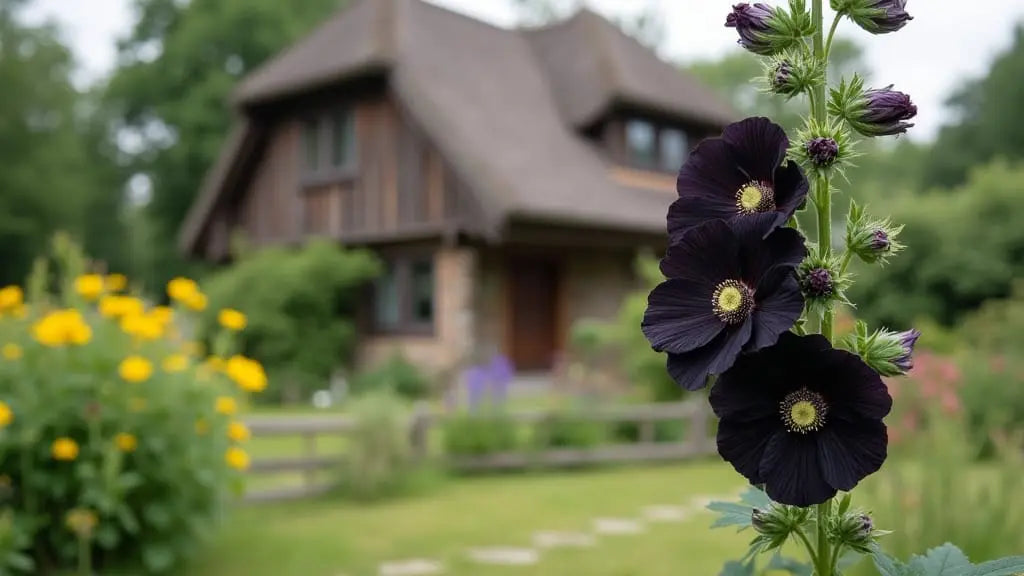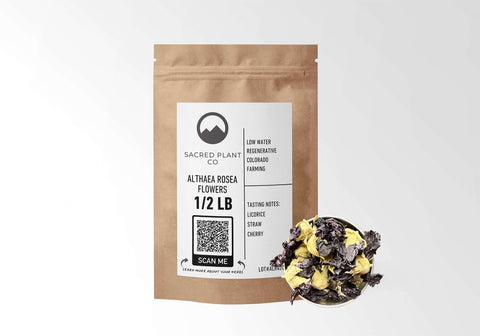A Tall Flower With Quiet Power
In the hazy heat of a midsummer garden, few sights rival the towering majesty of a hollyhock. Their spires sway gently in the breeze, blossoms unfurling in royal purples, pinks, and near-black maroon. But beneath this ornamental elegance lies a legacy of healing. Althaea rosea, cousin to marshmallow and mallow, has been cherished across continents for its ability to soothe, cool, and heal. What gives hollyhock its power isn’t just folk tradition: it’s mucilage-rich biochemistry, antioxidant pigments, and a gentle energetic profile that makes it an herbalist’s quiet ally.
Whether you sip it to relieve a scratchy throat, bathe in it to cool inflamed skin, or admire it for the bees it draws to your garden, Althaea rosea is a botanical that nurtures from the inside out.
Botanical Snapshot
-
Family: Malvaceae (mallow family)
-
Parts used: Flower, young leaf, occasionally root
-
Key compounds: Demulcent mucilage, flavonoids, anthocyanins, trace polysaccharides, minerals
-
Energetics: Cooling · Moistening · Soothing
-
Taste: Mildly sweet, faintly earthy
A Brief Stroll Through History
In Tang-era China, court physicians used hollyhock poultices to treat battlefield burns. Across medieval Europe, villagers brewed cooling infusions from the flowers when heat or hoarseness took their voices. Its petals made their way into broths and syrups, both for medicine and for survival.
-
Tang-era China: Petal poultices for burns and swelling
-
Medieval Europe: Cold infusions for hoarseness and dry cough
-
Middle-Eastern apothecaries: Syrups for inflamed stomach lining and respiratory complaints
-
Victorian herbals: Used as a gentler substitute for marshmallow in children’s remedies, including skin powders and sunburn compresses
The name "hollyhock" is believed to derive from "holy hoc" — "hoc" being an old word for mallow. Pilgrims brought the plant west from the Holy Land.
Phytochemistry Meets Modern Research
Hollyhock’s most famous trait, its rich mucilage, is more than a gooey coating. This slimy polysaccharide matrix forms when water interacts with hollyhock’s complex carbohydrates, creating a gel that physically binds to epithelial tissue. It’s not passive; studies show mucilage can modulate inflammation by inhibiting prostaglandin production and may even delay gastric emptying, which explains why it was once a folk remedy for ulcers.
The flower’s deep violet hue comes from anthocyanins, which have been shown to reduce oxidative stress in skin cells and may protect against UV-induced damage. In one in vitro study, anthocyanin-rich extracts supported fibroblast regeneration—a potential explanation for hollyhock’s enduring use in salves.
Finally, its water-soluble polysaccharides not only soothe but appear to stimulate mild immune activity, possibly explaining why traditional apothecaries turned to hollyhock syrup for the early stages of infection or when bronchial inflammation set in.
Why Herbalists Still Reach for Hollyhock
-
Throat & respiratory relief: Mucilage coats tissue, easing dryness and tickly coughs. Tip: use a cold infusion—heat lowers mucilage.
-
Digestive comfort: Soothes gastritis, heartburn, and gut inflammation. Sip 30 minutes before meals.
-
Skin rescue: Anti-inflammatory polysaccharides calm redness, burns, and eczema. Apply a cooled tea compress.
-
Urinary & reproductive support: Traditional diuretic; eases irritated urinary tract lining. Pair with marshmallow or corn silk.
How to Work With Althaea rosea
1. Cold-Infusion Throat Elixir
-
Add 1 Tbsp dried hollyhock blossoms to a pint jar.
-
Cover with room-temperature spring water.
-
Steep 4–6 hours (or overnight in the fridge).
-
Strain and sip ¼ cup hourly to maintain the soothing coating.
2. Skin-Soothing Poultice
-
Grind 2 tsp blossoms with 1 tsp oat flour.
-
Mix with warm water to a paste.
-
Apply to clean skin for 15 minutes; rinse and pat dry.
3. Culinary Twist
Tender young leaves lend an okra-like silkiness to summer soups, while petals turn lemonade a delicate pink and add bonus antioxidants.
Spotlight Recipe — Hollyhock & Chamomile Soothe-All Tea
Ingredients (makes 2 cups)
-
1 tsp dried hollyhock blossoms
-
1 tsp dried chamomile (Matricaria recutita)
-
1 thin slice fresh ginger (optional)
-
Raw honey to taste
Method
-
Place herbs in a teapot.
-
Pour 500 mL water just off the boil; cover.
-
Steep 10 minutes; strain.
-
Sweeten, inhale the floral steam, and sip slowly.
Regenerative > “Organic”
At Sacred Plant Co we go beyond certificates: our hollyhock rows are regeneratively grown, pesticide-free, and lab-tested for purity. Every harvest supports pollinator habitat and carbon-rich soils, because true plant medicine starts with living earth.
Safety & Contraindications
-
Generally regarded as safe in food amounts.
-
Medication timing: Mucilage can slow absorption—take hollyhock at least an hour after prescriptions.
-
Pregnancy: Traditionally safe in culinary doses; consult a practitioner for therapeutic use.
-
People with diabetes should monitor blood sugar when consuming large amounts.
Hollyhock FAQ
Is Althaea rosea the same as marshmallow (Althaea officinalis)?
They’re close cousins; both are mucilage-rich. Hollyhock petals contain more antioxidant pigments, while marshmallow root has denser mucilage.
Can I drink hollyhock tea every day?
Yes, 1–2 cups daily is generally safe for healthy adults. Rotate herbs weekly and consult a professional if pregnant or on medication.
Does heat destroy the mucilage?
Boiling water reduces viscosity. Choose cold or warm infusions for maximum demulcent action.
What does hollyhock taste like?
Mildly sweet and slightly earthy—much gentler than hibiscus.
Is hollyhock safe for children?
In mild tea or culinary amounts it’s considered gentle, but always dilute for kids and watch for individual sensitivities.






